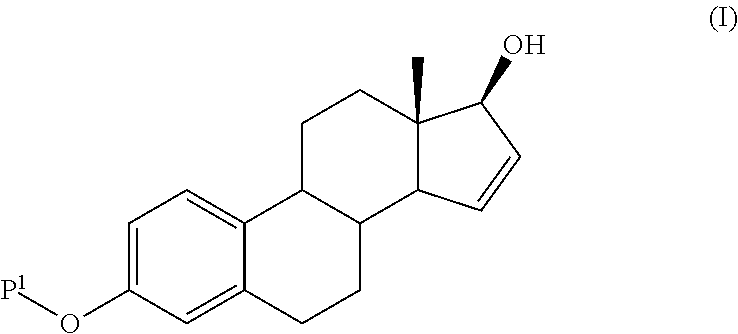Process for the production of estetrol intermediates
a technology of estetrol intermediates and estetrol, which is applied in the production of bulk chemical products, immunological disorders, drug compositions, etc., can solve the problems of low yield of -16 double bonds, two-step protection/deprotection of the 17-keto function, and the protection of the 3-oh function with a benzyl. , to achieve the effect of lowering cost and yield
- Summary
- Abstract
- Description
- Claims
- Application Information
AI Technical Summary
Benefits of technology
Problems solved by technology
Method used
Image
Examples
example 1
Preparation of a Compound of Formula (I) wherein P1 is tert-butyldimethylsilyl According to an Embodiment of the Invention
Step 1: 3-tert-butyldimethylsilyloxy-estra-1,3,5(10)-triene-17-one
[0073]To a solution of 3-hydroxy-estra-1,3,5(10)-triene-17-one (100 g, 0.370 mole) in 500 ml of dichloromethane was added tert-butyldimethylsilyl-chloride (58.3 g, 0.388 mole) and imidazole (26.4 g, 0.388 mole). The mixture was stirred for 24 hours at room temperature. Water (300 ml) was added and the organic layer was washed with 200 ml of water. After concentration the product was crystallized from a mixture of ethanol / diisopropyl ether, collected by filtration and dried. It weighted 145 g (95% yield).
[0074]1HNMR (CDCl3) δ 0.20 (s, 6H, (CH3)2—Si—), 0.90 (s, 3H, CH3 at C-18), 1.00 (s, 9H, (CH3)3—C—Si—), 1.20-2.60 (m, 13H), 2.75-2.95 (m, 2H), 5.65-5.75 (m, 1H), 6.58 (broad s, 1H, H4), 6.63 (dd, 1H, H2), 7.12 (d, 1H, H1) mp: 171.6° C.
Step 2: 3-tert-butyldimethylsilyloxy-estra-1,3,5(10)-15-tetraene-...
example 2
Preparation of a Compound of Formula (I) wherein P1 is tert-butyldimethylsilyl According to an Embodiment of the Invention
Step 1: 3-tert-butyldimethylsilyloxy-estra-1,3,5(10)-triene-17-one
[0080]3-tert-butyldimethylsilyloxy-estra-1,3,5(10)-triene-17-one was prepared as described in step 1 of Example 1.
Step 2: 3-tert-butyldimethylsilyloxy-estra-1,3,5(10)-15-tetraene-17-one (via X═Br)
[0081]Copper(II) bromide (100 g, 0.45 mole) was added to a warm solution of 3-tert-butyldimethylsilyloxy-estra-1,3,5(10)-triene-17-one (86.4 g, 0.225 mole) in methanol (500 ml) and the mixture was heated under reflux for 2 hours. The hot mixture was filtered and was poured in a mixture of dichloromethane (1000 ml) and water (800 ml). The organic layer was washed with water.
[0082]To this solution imidazole (18.3 g, 0.27 mole) was added and heated under reflux for 6 hours. After cooling water (500 ml) was added and the organic layer was concentrated. The residue was crystallized from a mixture of ethyl acet...
example 3
Preparation of a Compound of Formula (I) wherein P1 is tert-butyldimethylsilyl According to an Embodiment of the Invention
Step 1: 3-tert-butyldimethylsilyloxy-estra-1,3,5(10)-triene-17-one
[0086]3-tert-butyldimethylsilyloxy-estra-1,3,5(10)-triene-17-one was prepared as described in step 1 of Example 1.
Step 2: 3-tert-butyldimethylsilyloxy-estra-1,3,5(10)-15-tetraene-17-one (via X=pyridinesulfinic)
[0087]3-tert-butyldimethylsilyloxy-estra-1,3,5(10)-triene 17-one (8.64 g, 0.0225 mole) was added to a suspension of potassium hydride (3 eq. 35% dispersion in oil) in tetrahydrofuran 100 ml. methyl 2-pyridinesulfinate (5.3 g, 0.034 mole, 1.5 eq) was added. After 30 min at room temperature the reaction was poured into a sulfate buffer. The aqueous phase was neutralized by an aqueous solution of sodium carbonate then extracted with toluene. The solution was heated to 110° C. for one hour. After cooling to room temperature the solution was washed with a diluted solution of sodium hydroxide then...
PUM
 Login to View More
Login to View More Abstract
Description
Claims
Application Information
 Login to View More
Login to View More - R&D
- Intellectual Property
- Life Sciences
- Materials
- Tech Scout
- Unparalleled Data Quality
- Higher Quality Content
- 60% Fewer Hallucinations
Browse by: Latest US Patents, China's latest patents, Technical Efficacy Thesaurus, Application Domain, Technology Topic, Popular Technical Reports.
© 2025 PatSnap. All rights reserved.Legal|Privacy policy|Modern Slavery Act Transparency Statement|Sitemap|About US| Contact US: help@patsnap.com



